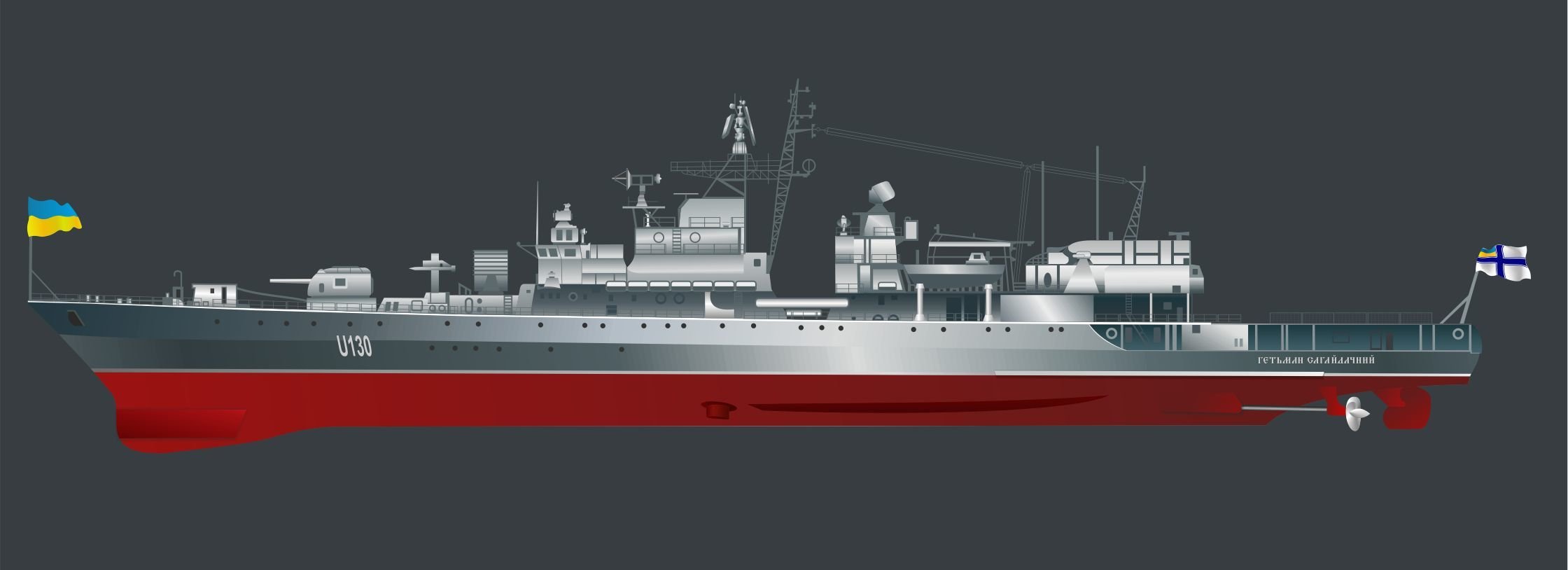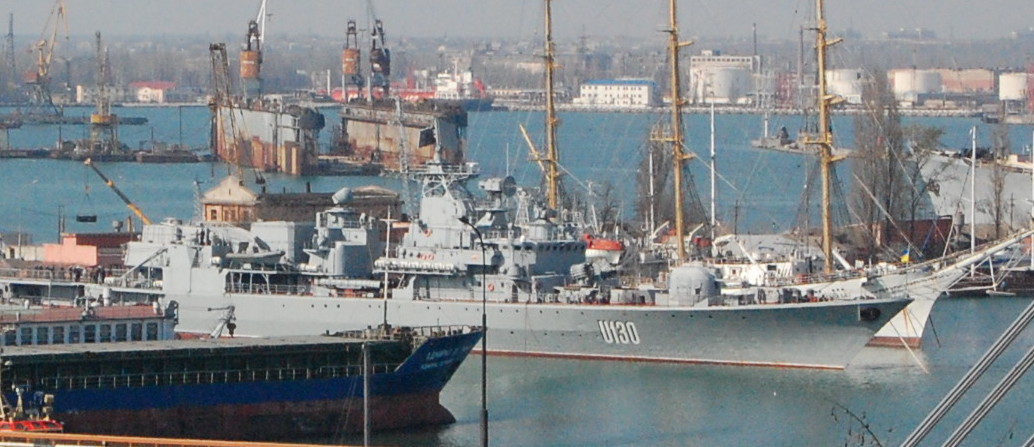ODESSA, Ukraine — The flagship of the Ukrainian sea service now sits parked in a commercial port in the picturesque seaside town of Odessa, more known for its nightclubs than its military infrastructure. Next to it floats a handful of tiny coastal boats sporting Ukraine’s colors, blue and yellow.
This is all that’s left of Ukraine’s navy.
When Russia rolled over Crimea in a practically bloodless invasion in February it took the lion’s share of Ukraine’s naval power, including nearly all of its blue-water ships, its officer training academy, maintenance facilities, shoreside infrastructure and even most of its sailors, who have either resigned from the military and left for mainland Ukraine, or switched sides and pledged allegiance to Russia.
The split has run all the way to the top of the service. Denis Berezovsky, who commanded the Ukrainian navy when Crimea switched hands, pledged his loyalty to the new self-declared Crimean government and stands accused of treason by the Ukrainian Security Council. His replacement, Rear Adm. Sergey Haiduk, was taken from the Sevastopol naval base by Russian special forces and dumped at the new border to make his way home on March 20.
The frigate now bound off the Odessa coast, the Hetman Sahaydachniy (U-130), was returning from a NATO anti-piracy patrol in the Gulf of Aden when Crimea fell. A Russian senator announced on March 1 that Sahaydachniy had hoisted the Russian flag, but the ship rolled into Odessa a few days later still flying yellow and blue.
A release on the Ukrainian military’s website quoted Sahaydachniy’s commander, Rear Adm. Andriy Tarasov, saying, “Ukrainian servicemen serve for the Ukrainian people and sail under the Ukrainian flag.”
According to Tim Ripley, an analyst with IHS Jane’s, it’s hard to say how many ships the Ukrainian navy lost because it’s hard to say how many it started out with.
“Lots of them are really old and decrepit and have been scrapped, and [Ukraine is] not really very transparent about that kind of thing,” Ripley said. “They had between 12 and 17 [large ships]. That’s frigates, corvettes, a single submarine and two big armed landing ships.”
 The submarine, he added, has never been used. It has spent its entire service life thus far under maintenance. Ukraine had only a handful of large vessels built after the 1991 collapse of the Soviet Union.
The submarine, he added, has never been used. It has spent its entire service life thus far under maintenance. Ukraine had only a handful of large vessels built after the 1991 collapse of the Soviet Union.
The last ship holding out for Ukraine on Crimea, a 37-year-old minesweeper named the Cherkassy (U-311), dodged Russian ships for weeks before it was boarded in late March, and its 50 crew members moved ashore.
Ripley said Russia promised via state TV to return some of the captured Ukrainian vessels, though it didn’t say how many or when.
The aging ships are a pittance for the Russian navy, which can already far outmatch its western neighbor. The real prize, he said, is the Crimea itself, and all the maritime infrastructure on it.
“The Russians call the Crimea an unsinkable aircraft carrier,” Ripley said. “It gives their naval forces so many more options to operate far from home and into the Mediterranean in a way that their northern fleet and their Baltic fleet are limited. Their Baltic and their northern fleets are iced in about three or four months a year, so this is a big prize, for the Russian navy to get the Crimea back.”
NATO may well be concerned about giving Russia such a valuable piece of land, but Ripley said the coalition’s forces are hobbled by treaties dating from the 1920s limiting excursions into the Black Sea by nations without a Black Sea coast. Under the 1936 Montreaux Convention, non-Black Sea-nation war ships can only sail there for a maximum of 21 days.
The U.S. sent a destroyer, USS Truxton, (DDG-103) into the Black Sea to participate in exercises when the Crimean crisis began, but it steamed elsewhere when its treaty-allowed time ran out. On April 10, America sent USS Donald Cook (DDG-75) into the Black Sea on another exercise mission, according to a Navy press release, “to reassure NATO allies of the U.S. Navy’s commitment to strengthen and improve interoperability while working toward mutual goals in the region.”
The U.S. has made noises about helping Ukraine rebuild its forces, and Ukraine has been asking to buy used Oliver Hazard Perry-class frigates since 2008. According to a U.S. diplomatic cable published by Wikileaks, the 2008 conflict between Russia and Georgia motivated Ukraine to beef up its naval defense. But American diplomats were skeptical.
“We assess that it is quite likely that Russia will use the acquisition as an opportunity for an anti-Ukrainian and anti-NATO public information campaign – most particularly directed to media outlets in Crimea,” diplomats wrote at the time. “The negative public relations campaign notwithstanding, our assessment is that an FFG is likely to do little or nothing to change the balance of power in the region.”
According to Naval Sea Systems Command spokesman Chris Johnson, Congress hasn’t approved any ship transfer legislation for this year, which would be required for a ship sale to Ukraine.
If Russia doesn’t stop with Crimea, Ukraine’s last naval port could be next on President Vladimir Putin’s list.
In an interview with CNN on April 2, NATO commander Gen. Philip Breedlove warned that Putin might be eyeing a Russian-speaking enclave between Moldova and Ukraine that has announced its independence.
“If the [Russian] forces along the southern part of the region were to move in to establish this land bridge … if you look, to the Port of Odessa, and there — if you just look, very close by is the Transnistria region,” he said. “So clearly these are also options that this force could bring to the table.”
Ripley pointed out that Odessa would be the perfect site for an amphibious landing force that could then make its way to Transnistria via river. If Mykolaiv, a port in between Odessa and Crimea, were cut off as well, it would leave Ukraine effectively landlocked.
And it’s possible many Odessans would not be adverse to such a move.
At a rally celebrating the anniversary of Odessa’s April 10, 1944 liberation from the Third Reich, the air above the crowd was thick with Russian flags and shouts of “Russia! Russia!” A few old-timers even sported banners bearing Stalin’s portrait.
As at all Liberation Day celebrations, surviving Soviet army veterans who fought the bloody battle for the port are the guests of honor, presented bundles of flowers while crowds chant “Thank you!”
Two men in white Ukrainian navy dress uniforms stood motionless on a balcony above the crowd, presenting the red flag that commemorates Odessa’s liberation.
As he turned to follow the marching pro-Russian crowd, an old man in a Soviet Navy uniform turned toward the two young sailors and lifted his bouquet of carnations in salute.





